The article discusses the goals and objectives of landscape lighting, the rules that need to be followed when creating a project, and choosing suitable lighting fixtures. Photos and videos of completed projects will vividly demonstrate the existing possibilities.
Main Objectives
Several landscape lighting schemes have been developed. They can be conditionally divided into two groups. One helps to create general lighting for the entire territory, while the other focuses on highlighting specific zones or objects. It is important to arrange the lighting fixtures in a way that allows for comfortable use of the outdoor area, safe movement around it, and performance of various tasks during evening hours.
To achieve the set goals, it is necessary to install:
- General lighting, including illumination of all paths, walkways, garage areas, terraces, gazebos, and the entrance porch.
- Masking lighting, which only outlines the contours of large objects located in the background of the area, indicating their borders and directing movement through separate zones.
- Protective lighting along the perimeter of the fence that deters intruders.
- Decorative lighting that transforms any dark garden into a magical fairy tale, used to highlight garden figures, large shrubs, and complex landscape design elements.
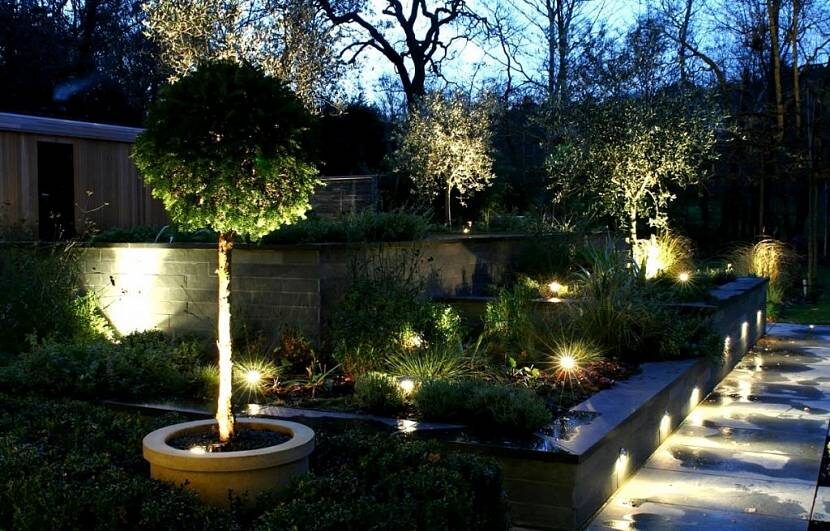
Creating all of this requires a competent approach to implementation. It is carried out during the landscape design stage, and all work is done before planting greenery.
Rules for creating
Various schemes are used in landscape lighting design. In each one, the fixtures simultaneously illuminate the front yard area and highlight the most picturesque zones visible from the windows of the house. Sometimes they mark private corners and actively flood the entrance areas with light. Taking into account this complex of requirements, it is easy to determine:
- how many fixtures need to be purchased;
- what their shape and size should be;
- where the light will be directed after installation.

Designing landscape lighting generally involves several stages. Initially, specialists photograph different sides of the area during daytime, producing a digital image that highlights all objects requiring illumination. They then use schematic diagrams to pinpoint the main locations for installing selected lighting fixtures.
When crafting a project, it’s vital to illuminate the main objects like the house, driveways, and garage. Next, highlight background elements, mark local points, and finally, create smooth transitions between these structures.
The lighting for architectural objects should emphasize the building’s beauty, the texture of the walls, or the roof’s uniqueness. Thus, lighting fixtures can go on building roofs or embed in the ground along the foundation’s perimeter. Such details ensure the house remains attractive, even at night.
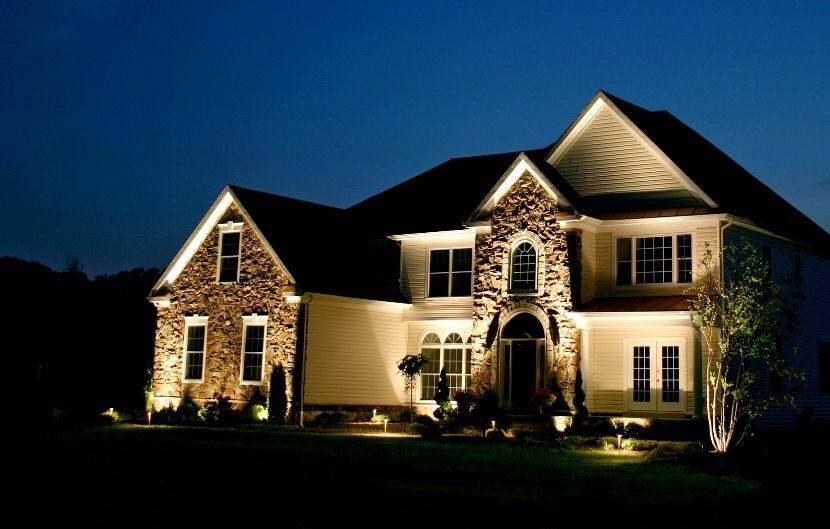
It is essential to place lighting near any obstacles, natural or artificially created. If there is a body of water on the site, it is important to mark it around the perimeter. Otherwise, it can be easy to fall into the water in the dark. By placing light fixtures along the shores and directing the light into the depths of the pond, any puddle will appear to be very deep in the evening. If projectors are installed on the bottom or on the surface of the water, the effect of the lighting will be the opposite: instead of a scary abyss, a mysterious object with water surface will appear on the site.
When illuminating shrubs, specialists recommend hiding the light fixtures inside the crown or foliage. This way, any branching plant will look very voluminous, and the reflections of the branches on the ground will form a beautiful flowing stream of winding shape.
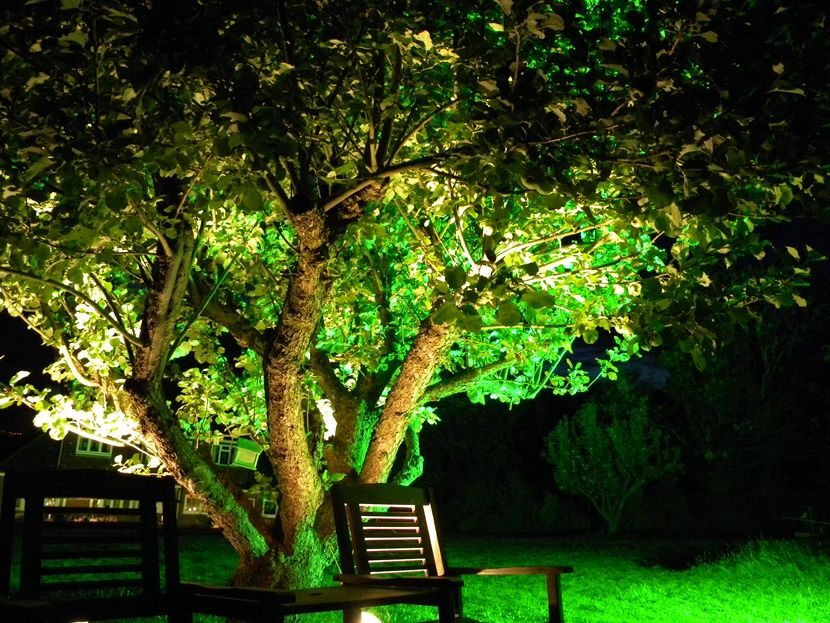
A beautifully lit alpine hill looks great in the evening. It can be illuminated in different ways. A good solution is to install a single torchiere at the top, which pours a stream of light from top to bottom. Small lights can also be installed around the base perimeter, with the light flow directed upwards. Both options, as practice shows, cope well with the task. If there is a desire to approach the lighting of the alpine hill in a non-standard way, you can hang a garland along its two slopes.
Designers love to illuminate flower beds and rose gardens with large lamps placed in the very center of flowering. Soft light is often enough to showcase the charm of the designated object in the dark.
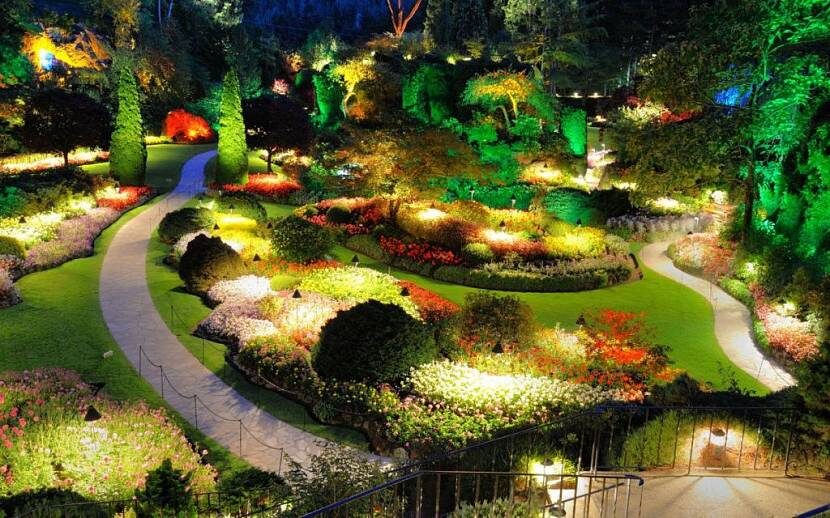
At the second stage of design, lighting fixtures are selected. When purchasing them, it is important to take into account the architectural and landscape thematic concept.
Which devices are best used for the stated goals
Developing landscape lighting projects typically includes two or three purely functional forms in the scheme. Each form employs specific lanterns and lamps. For instance, when creating general lighting, floodlights, standing lanterns, and pendant lamps are necessary. For pinpoint lighting, spotlights and projectors work best.
Various models exist, ranging from modern design to those stylized as antiques, equipped with glass shades or wrought iron elements. The choice of luminaire shape depends on the overall stylistic concept. These elements underscore the theme’s direction and set the tone for selecting other landscape design decor.
The main thing is to choose the type of lighting fixtures taking into account their technical components. Several types of artificial light sources are available for sale.
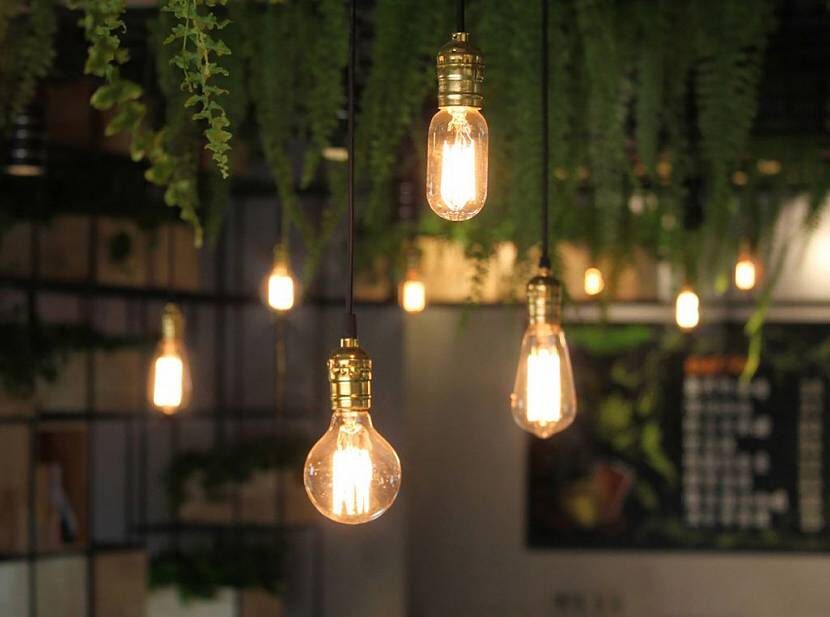
Incandescent lamps have a light emitter inside the bulb, which looks like a filament or spiral. It is made of a refractory metal. Today, these products are rarely used for outdoor lighting because they have low light output and produce a weak light stream. Their service life is not very long, only about a thousand hours.
Halogen lamps, on the other hand, are devices that have a bulb filled with inert gas and halogens. When turned on, these lighting fixtures provide a natural spectrum of light, twice as much as the previous type, and last four times longer than incandescent lamps. By installing them, you can save up to 80% of electricity.
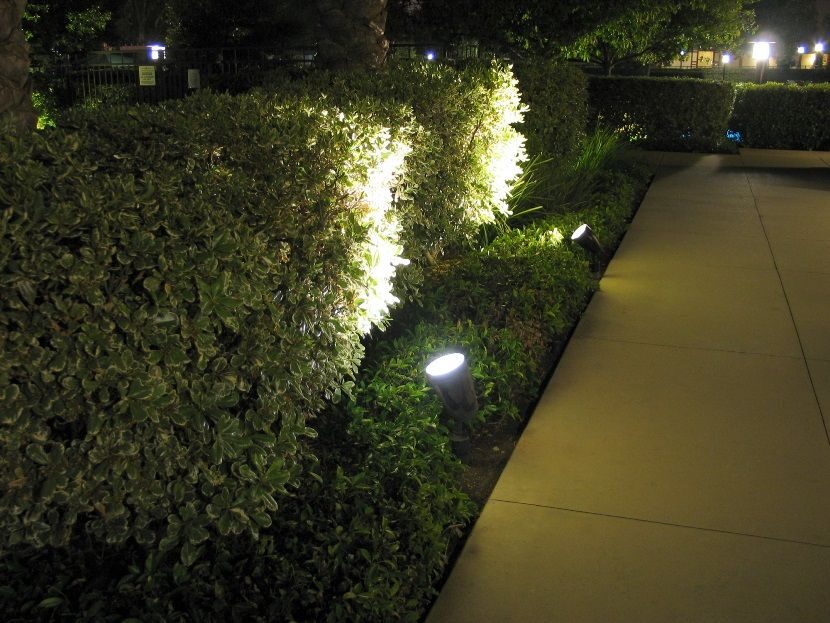
Metal halide lamps emit a very bright light beam. Designers like to use these devices for illuminating building facades or tall trees. They are also ideal for marking the perimeter of bodies of water.
Mercury vapor lamps are good for decorative lighting. Their design consists of several main elements: a contact part (socket), a quartz bulb containing inert gas and mercury, and an inner bulb (made of thermostat glass). Installing them helps save electricity (compared to incandescent lamps, it is possible to reduce utility bills by five times). When turned on, they do not flicker like fluorescent lights, and their average service life is fifteen thousand hours.
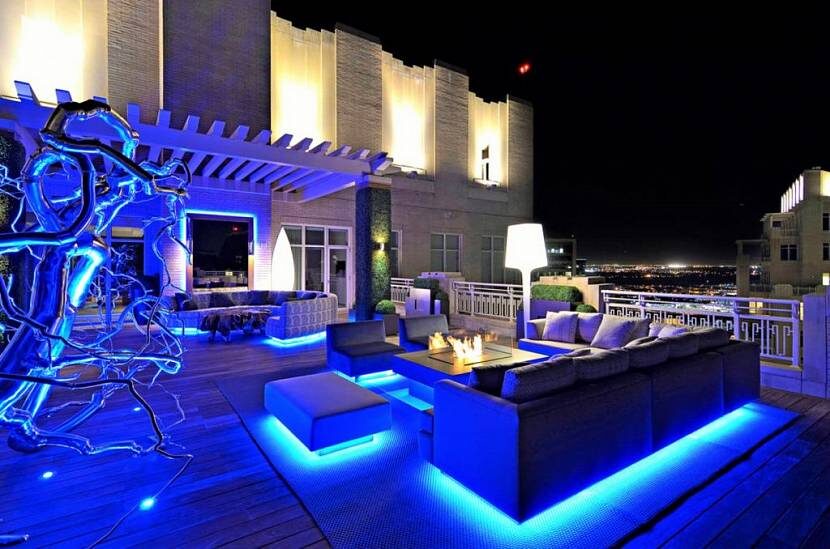
LEDs are the perfect lighting fixtures for landscape lighting. With them, you can highlight the complex relief of the site, provide illumination for stairs, gazebos, open terraces, paving, and retaining structures. They have excellent light output while consuming a minimal amount of energy. The lifespan of one lamp is one hundred thousand hours.
Fiber optics represent the latest innovation in landscape lighting. They enable the creation of additional light sources and a unique atmosphere. As fiber optic cables are moisture-resistant, they confidently serve in lighting outdoor pools, fountains, and other features where contact between fixtures and water is inevitable.
Two types of cables exist, each with its own technical characteristics. For instance, a glass cable can transmit light up to ten meters away, making it suitable for creating camouflage lighting. A synthetic cable, on the other hand, offers soft diffused light, suitable only for decorative lighting. Installing these fixtures is straightforward: you place the cable in the desired location and connect it to a power source.
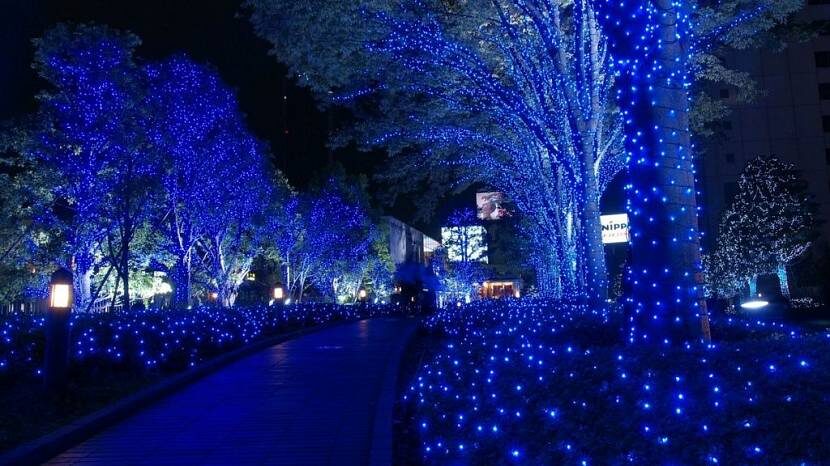
One can experiment with illuminating plants using different types of lamps: fluorescent lamps for flower beds, mercury lamps for trees, and incandescent lamps for shrubs. This creates a magnificent spectacle. The different effects of lighting depend on the different methods of mounting the lighting fixtures. They can be installed at the base, attached to the middle of a tree, or hidden in the foliage. The second and third options are best for highlighting individual, standalone trees or shrubs.
When choosing types of lighting fixtures, attention should be paid to the labeling of the devices. For outdoor lighting, fluorescent, sodium, mercury, and halogen lamps are all suitable options.
Lighting Layout and Installation
Once you purchase all the lighting equipment, you can begin laying out the lighting system according to the pre-prepared plan. This layout will guide you on where to dig trenches for the communication lines. Next, you can lay and hide cables in them inside special protective boxes.
You should only install the lighting fixtures after laying the main communication lines. Carry out equipment installation step by step, connecting lighting fixtures, switches, and panels to the electrical wiring. This setup will enable manual control of all existing scenarios. You should install the electrical panel in a place shielded from precipitation. Before filling in the trenches, it’s crucial to check the functionality of the assembled system. Grounding the system during installation is mandatory, as is installing devices that stabilize the network voltage.
Summary
From everything mentioned above, it can be seen that there are many options for landscaping lighting. When creating a lighting plan, various nuances should be taken into account, but the main criterion becomes the financial possibilities of the owner of the suburban area. You can get by with a minimum, choose inexpensive lanterns for landscaping lighting and install them only along the driveway to the house. Or, you can actively use all types of outdoor lighting, plan and assemble two branches that will be used depending on the season. When plants are actively living and blooming, the light should only accentuate their beauty. In winter, when nature is asleep, colorful lighting will create an artificially beautiful picture.


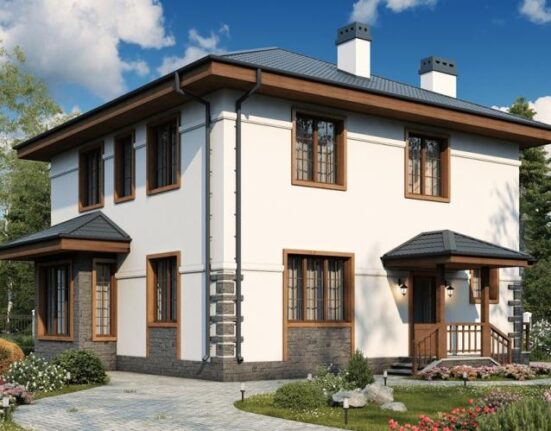

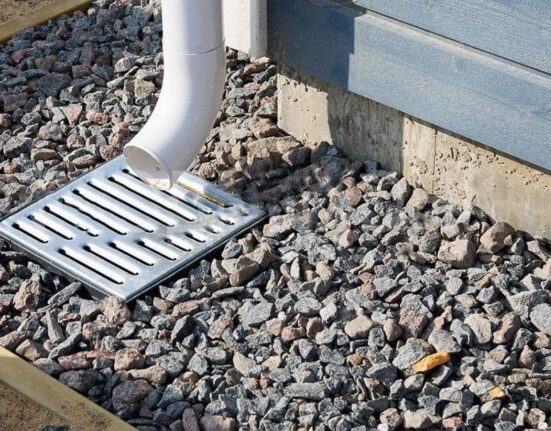
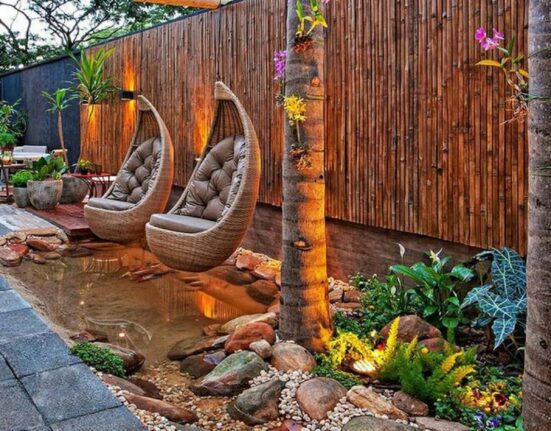
Leave feedback about this